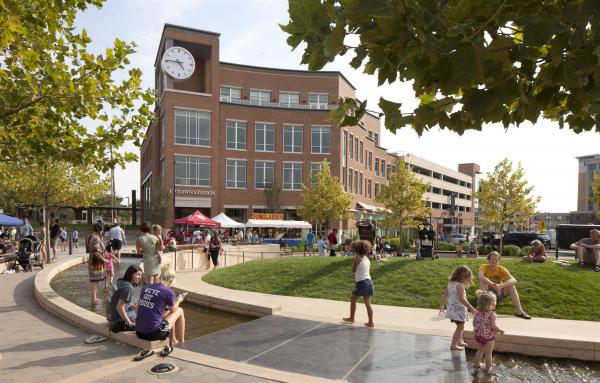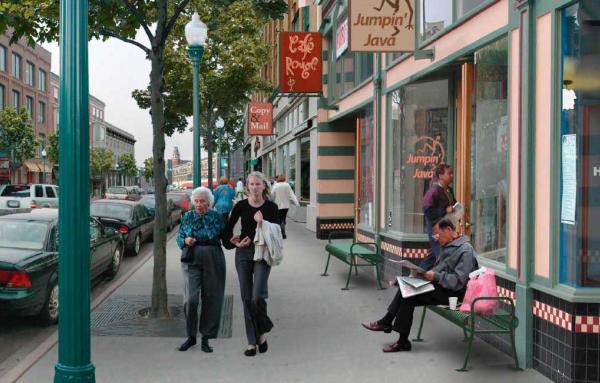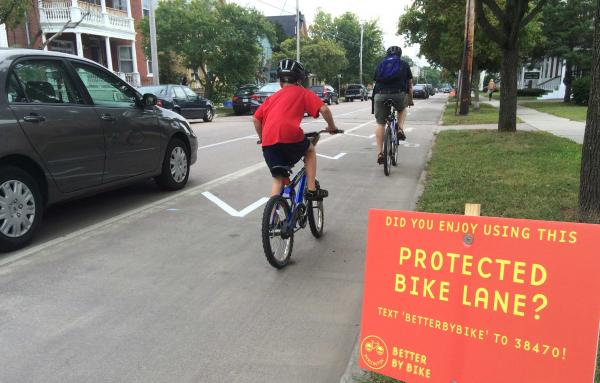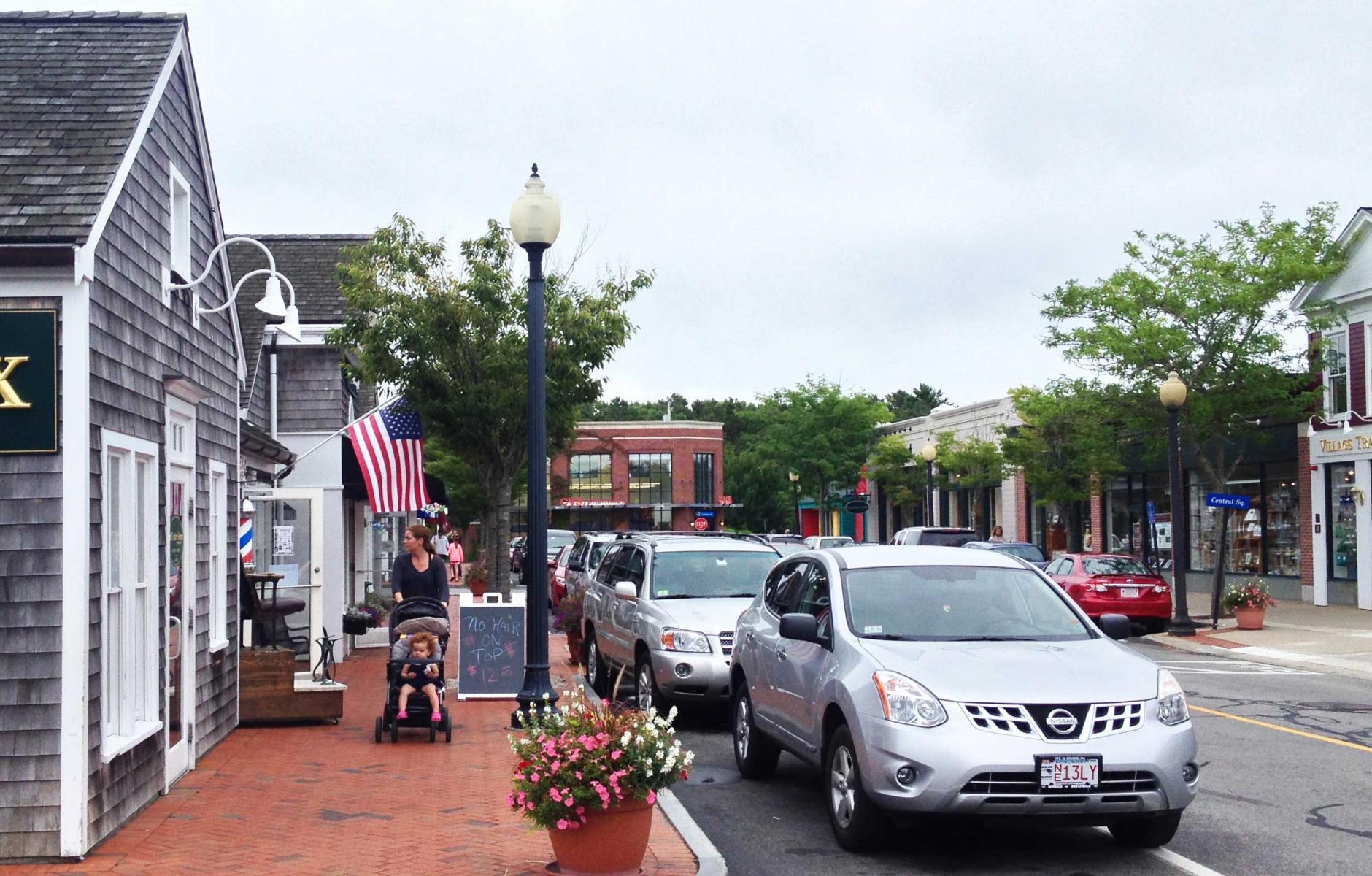
Great Idea: Building better suburbs through retrofit
In celebration of the upcoming CNU 25.Seattle, Public Square is running the series 25 Great Ideas of the New Urbanism. These ideas have been shaped by new urbanists and continue to influence cities, towns, and suburbs. The series is meant to inspire and challenge those working toward complete communities in the next quarter century.
Urbanism is not just about cities. The Charter of the New Urbanism calls for "the reconfiguration of sprawling suburbs into communities of real neighborhoods and diverse districts." That "reconfiguration" has inspired the creative energies of new urbanists and like-minded reformers for three decades, beginning with projects like Mashpee Commons in Mashpee, Massachusetts, where the former parking lots of a shopping center were rebuilt as main streets—see photo above. This idea is likely to keep urbanists busy for a long time—suburbs are constantly changing and have vast potential to meet the growing demand for walkable places, a market that cannot be satisfied by traditional cities alone. As millennials age, many will look to find walkable neighborhoods in the suburbs.
Public Square editor Robert Steuteville interviewed Ellen Dunham-Jones, director of the Urban Design Program and Professor in the Georgia Tech School of Architecture and co-author, with June Williamson, of Retrofitting Suburbia, and Galina Tachieva, principal at DPZ Partners and author of Sprawl Repair Manual. Dunham-Jones and Tachieva discuss the retrofitting of malls, office parks, parking lots, streets, McMansions, campuses, and other aspects of America's suburbs into more diverse, connected, complete communities.
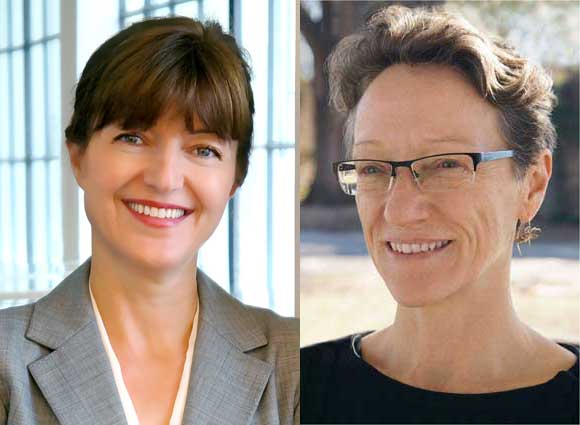
Several years ago, CNU launched a suburban retrofit initiative, and lately, it's been re-branded as Build a Better Burb. Can you tell me a little bit about the history of this, and where CNU's efforts are heading?
Tachieva: In 2008, members and leaders of CNU had several brainstorming meetings to launch the sprawl retrofit initiative. Until that moment many of us had worked on multiple retrofitting projects, but these efforts were not yet organized into a Congress-driven initiative. We started by sharing ideas and developing resources. In the meantime, many projects came out of the ground. And it had soon become obvious that there was a whole movement in this direction—that the suburbs will be the next great frontier for planning and retrofitting. The idea of rebranding the sprawl retrofit name came recently. Not everyone responds well to terms like “sprawl” and “retrofit,” so the CNU Council held in Miami last spring rebranded the initiative into Build a Better Burb.
So Build a Better Burb is more geared towards the mass market. But what differentiates the communities that are succeeding in reforming their conventional suburban fabric from those that aren't?
Ellen Dunham-Jones: There are several factors. Those that are really successful have a champion—usually someone in the public sector but often a developer. That also means there has to be a lot of political will to invest public money in the infrastructure changes that are necessary. The other thing June Williamson and I have noticed is that the communities where you see a lot of redevelopments tend to have large planning staffs with the capacity to negotiate public-private partnerships. In addition, it really helps, though it's by no means necessary, if they already have a rail or light-rail system. So DC, Denver, Vancouver, San Francisco and more recently, Atlanta, Austin, Phoenix, Dallas,—are places where a lot is happening. There's all sorts of retrofitting going on in communities that don't have those particular assets, but it tends to take a different format, and it tends to move more slowly.
Tachieva: Urbanizing and retrofitting in the suburban areas is obviously a choice, and Ellen pointed out to the importance of a champion, whether a mayor, or a planning department, or a private entity. And the communities which have been retrofitting are the ones that attract new businesses. There have been good examples already, such as Downtown Doral (Florida). The City of Doral chose to incorporate and to urbanize intensively. It is an interesting example because they are doing multiple projects—high-density, mixed-use projects to attract businesses. They have decided not to focus on one “silver bullet”, such as a stadium, a park, or something which they will do in one shot, but to retrofit holistically using the elements of a city—streets lined with shops, walkable blocks, civic buildings, well-defined and programmed open spaces—to mix together in a real urban fabric, not isolated enclaves.
The idea of suburban retrofit began with dead and dying malls, strip malls and enclosed malls. Are the malls still where the action is? And what other property types are emerging as opportunities?
Dunham-Jones: I think the malls have always gotten the most media attention because they're so visible, and most of us have spent time in malls. Right now there are about 200 enclosed malls in various stages of significant redevelopment—63 of those as mixed-use downtowns. Another 136 are being significantly re-inhabited with an entirely different, more community-serving use. These numbers are likely to continue to grow as retail continues to shake out.
But where I'm seeing the most growth now is in retrofits of dying office parks and corporate campuses—such as the Downtown Doral project Galina just mentioned. High-paying jobs are increasingly moving back into cities leaving suburban communities with significantly less tax revenue and out-of-date cubicle farms. About 80 of them currently are planning to infill with mixed use, to re-inhabit the office buildings—either turn them into housing or something else or just completely redevelop them. These are very large properties, and it's going to take a long, long time for them to truly realize urbanism.
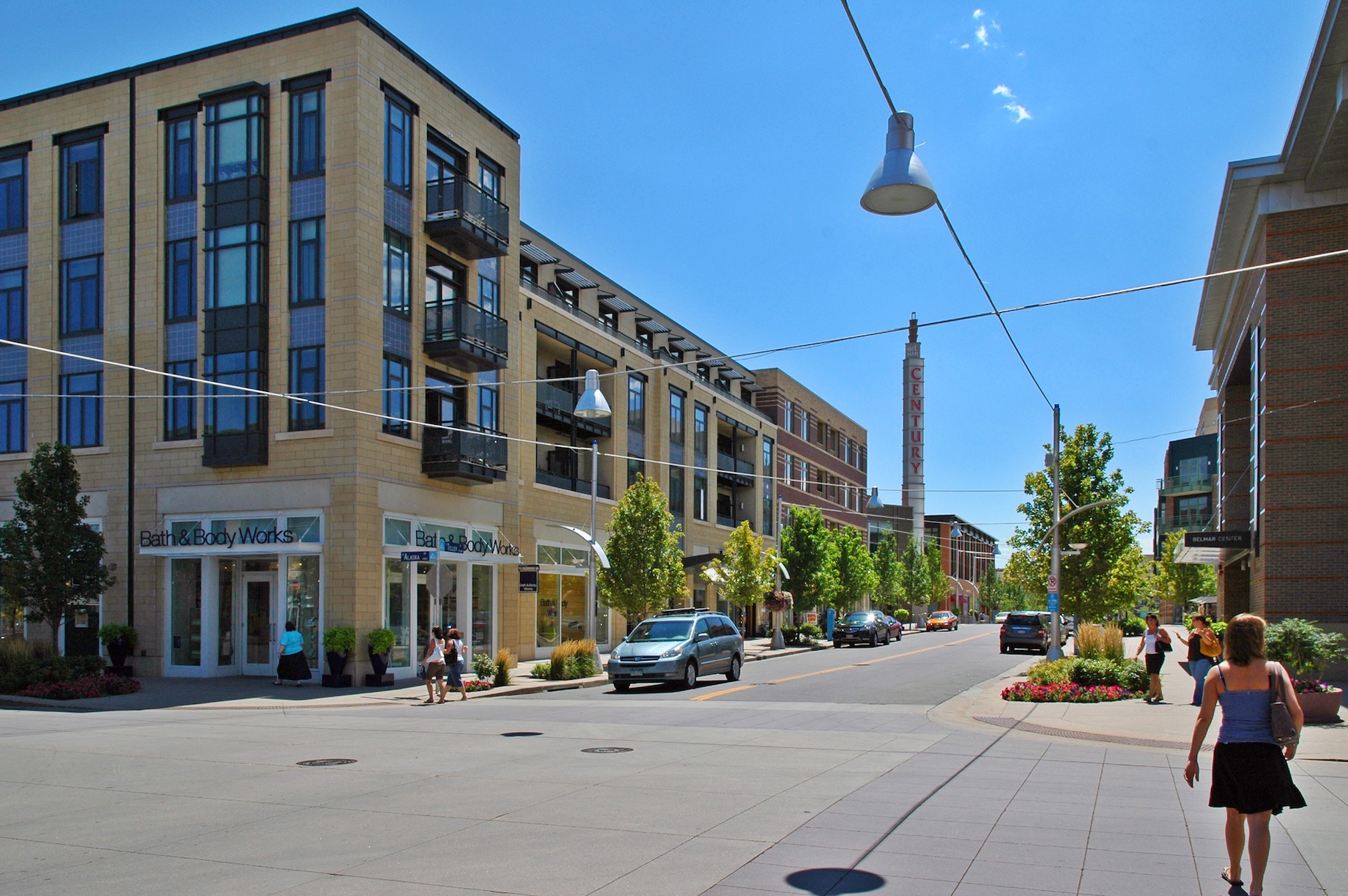
Tachieva: I still think that the malls will remain big players in the retrofitting business, for the reason of their location, size and the opportunity that comes from single ownership.
Another opportunity for suburban retrofits are the suburban campuses. Both educational, the large universities, which are in suburban locations where the students commute because they lack the proper housing nearby, as well as the medical campuses—these are another huge opportunity for the coming decades. With baby boomers aging, they will seek to be near health facilities—and if we embed hospitals and clinics in walkable environments, that's a win-win. Already healthcare systems have been seeking to do exactly that—to predict and plan for future expansions with mixed-use town centers around their facilities.
You have these single-use suburban places that are being redeveloped. Are these projects becoming complete communities all at once, or is the transformation more incremental?
Dunham-Jones: Both are happening – it mostly depends on the market. If you can get 50-100 acres—in some of these office parks you're getting 1,600 acres—the big developers in strong markets are certainly able to put in truly urban, mixed-use, complete communities. But what's also been happening, very much as a result of the Sustainable Community Partnership Initiatives under the Obama administration, is that hundreds of corridors throughout the country have now been rezoned to allow for that incremental redevelopment parcel by parcel.
You mentioned the office or industrial park transformations. How do the suburbs escape from that office industrial park mentality and meet the employment needs of the 21st century?
Dunham-Jones: Urbanism is the new amenity. So many of the office parks are aging now, and the market has moved back into the city. That's where the employees are that they want to hire. So the office parks are trying to bring in some of that walkable mixed use and bring in a main street, bring in more housing, bring in the kind of urbanism that allows them to attract young workers. We're also seeing that a lot of first generation retrofits like Santana Row initially had a lot of retail and residential, and only a little bit of office. Now that they have the urbanism in place the second and third phases are bringing in millions of square feet of office.
Galina, do you have thoughts on the employment issue in the suburbs?
Tachieva: In the existing vast areas of single-use residential development there may be an opportunity to do something on the smaller scale, especially in the nooks and crannies around highways and interchanges, in the so-called “edgeless city” areas where there are smaller office and warehouse clusters. At least we have seen this desire for creative co-working spaces for entrepreneurs, who live in the suburbs because of the schools, but they are young and creative, and they would like to work in creative, sociable environments. So the smaller-scale, incremental infill and adaptive reuse of existing buildings, whether it’s aging office parks or warehouses, offer opportunities for this type of development. The ‘solo-preneur’ business owners who are doing the work from their homes but often collaborate on projects, would prefer to mingle in comfortable, inexpensive co-working hubs. Ideally the work space will be mixed with some other activities, whether it's food and beverage, a community garden, a market or a civic amenity.
How can the suburbs transform to meet the needs of millennials, and are the millennials themselves transforming the suburbs in their own way?
Dunham-Jones: Most of the suburban retrofits are providing an urban lifestyle for suburban millennials already. But I think what's going to be interesting to watch is as the millennial moms and dads move into suburban single-family homes and neighborhoods—they're going to bring their smartphones and the sharing economy with them. Uber, already in southern California, has been demo-ing a service that is extremely popular called UberMoms. All it means is that when you select that option, the driver is a mom. It doesn't guarantee safety—but a lot of Southern California moms feel a lot more comfortable sending their kids to soccer practice in an Uber Mom car. UberBike has been demo'd in Miami—it’s an Uber that has a bike rack. I think we're going to see a market for more of those kinds of services, more missing middle housing with communal courtyards and social space even in the very traditional single-family home neighborhoods because this is a generation that's going to bring their apps and sociability with them.
And at the other end of the spectrum, we're an aging society. Baby boomers are becoming senior citizens. How do we make the suburbs places where people can age in place comfortably?
Tachieva: This is a challenge. So many residential subdivisions with cul-de-sacs are not comfortable for the aging population. Sooner or later driving becomes difficult and at some point impossible for older people. Aging Baby Boomers would like to remain healthy and active for a long time and some of the retrofits on the larger scale will provide amenities. However, specific groups of the population where assisted living is necessary pose real challenges. The Supportive Living Module is an idea for infill in the form of a traditional two- or three-story building where seniors can receive skilled, community-based assistance. Because the building is small in size, it is easy to manage, and its scale is appropriate for the residential subdivision, providing necessary services in close proximity to community and family.
Dunham-Jones: Wayzata, Minnesota, has just redeveloped a dead mall with senior housing as part of a mixed-use extension of the main street. It had a waitlist, even before construction. It's allowing seniors to age in their community so that they're near doctors and friends while being better able to participate in everyday activities outside their front door. I also like the Living Streets project in Maplewood, Minnesota. As part of a watershed program to try to reduce the amount of runoff going into the sewers and lakes, they're narrowing their streets while they put in rain gardens. In the process, they're building new sidewalks. That’s a great triple whammy of cleaner water, narrower, safer streets, and sidewalks. In a community of 30,000 people, they’ve made 80 of their streets more walkable. It's going to take that kind of scale to make our communities easier for people to age in place.
Tachieva: I just wanted to add one more opportunity: the retrofit of the McMansion. There are so many McMansions within suburban subdivisions that are underutilized and can be turned into a kind of the old-style boarding houses, whether they will be student housing or senior housing—when most people become single later in life or they need some kind of help.
Dunham-Jones: Like The Golden Girls tv show! We see some of that in Atlanta where intergenerational households, especially immigrant families, love the McMansions.
What are some of the other innovative retrofit ideas that you've seen that you think you'd like to see more of in the suburbs?
Dunham-Jones: So I'm going to make a pitch for a session that I'll be giving at CNU 25. I'm very excited about the retrofit innovations I'm seeing in how we deal with water. A developer in Portland has built the nation's largest organic water recycling machine as part of his redevelopment of former parking lots. It's recycling both the gray water and the black water. You can say, "Oh, well it's Portland. They always do the most progressive things." But no, he's doing it because it saved him $1.5 million in sewer impact fees. ParkMerced outside of San Francisco is a 3,000-plus-unit apartment complex. For over 75 years, every drop of rainwater has been taken away from the area in sewer pipes. As a result, the aquifer is going dry. The retrofit will more than double the occupancy, while it also removes ev all those pipes and redesigns the landscape and buildings to recharge the groundwater. Thirdly, it’s really great to see how our combined sewer overflow problems are being addressed by replacing dead malls and parking lots with stormwater parks, adding climate change resiliency. We need way more of sprawl to be regreened!
Tachieva: Another innovative retrofit that I see starting to happen is public housing. There is so much public housing that is not located within the urban core, nor along public transportation lines, and usually without any amenities. They present large challenges as people don’t have easy access to daily needs. Some recent federal programs encourage the private sector to come in and take over some of those properties for a period of time, fix them and manage them. It's important not to think about only fixing the buildings, but also retrofitting the surrounding context and make the neighborhood more pedestrian-friendly. This is an area where we can help.
What are some of the future challenges facing suburbia that haven't been addressed and we need to start thinking about?
Tachieva: Of course, there are many, starting with its sheer scale. If anybody takes a drive outside of a city and looks carefully will be shocked by the over-engineered, gold-plated, however—in many cases—already crumbling infrastructure that supports sprawl. And it will take a few generations to fix it. However, for us to be successful, we have to look at the roots of sprawl. Levittown changed the pattern of building communities in the United States because William Levitt created a normative product, the auto-dependent suburban enclave, which he could repeat easily. So we have to come up with normative step-by-step tools to retrofit suburbia in the way it was built.
Note: CNU intern Benjamin Crowther helped to produce this interview and article.





